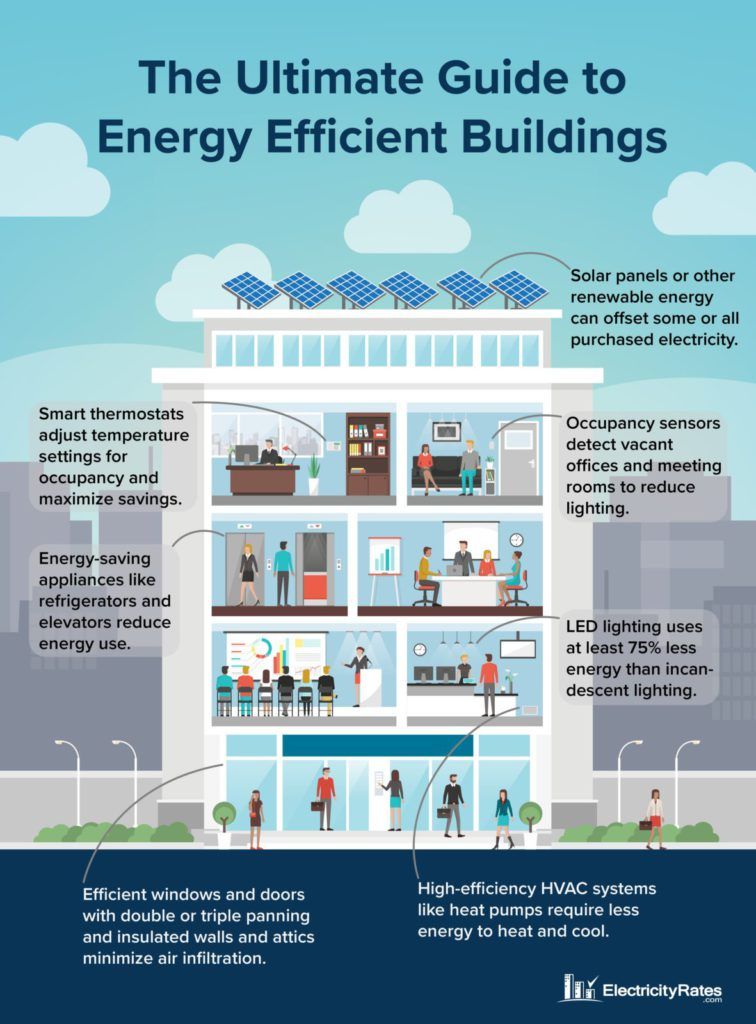The browser you are using is not supported. Please consider using a modern browser.

The Ultimate Guide to Energy-Efficient Buildings
Table of Contents

Our buildings don’t get as much attention as transportation regarding energy efficiency. But here’s a shocking fact – buildings are responsible for 40% of total energy consumption and over half of carbon emissions in the USA.
An energy-efficient building saves energy while still being comfortable and functional.
Buckle up as we cover some surprising truths on how our buildings drain energy and what we can do to change it! And how you can lower your electricity bills by taking advantage of competitive rates on Electricityrates.com.
What is an Energy Efficient Building?
An energy-efficient building is designed and constructed to maximize energy performance and efficiency. This is done using different features and technologies to decrease the energy needed for daily tasks and occupancy.
Energy-efficient buildings use less energy but still provide the same level (or more) of comfort and guest satisfaction. Efficient homes consume 40% less energy compared to regular ones. Additionally, high-performance commercial buildings have the potential to be 50% more efficient.
How do you determine if your building is energy efficient?
There are a few ways to determine your building’s efficiency:
- Energy audits – A professional energy auditor will assess the building envelope, systems, and equipment to identify efficiency opportunities. This involves blower door tests to detect air leaks, inspecting insulation, analyzing appliance efficiency, etc.
- Building certifications – Green building certifications like LEED and EnergyStar provide third-party energy efficiency verification. Achieving certification at higher tiers requires meeting strict energy performance criteria.
- Benchmarking – Comparing a building’s energy use per square foot to the national averages for similar building types. More efficient buildings use less energy per square foot.
- Performance testing – Specific tests like ASHRAE Level I, II, and III energy audits compare the building’s modeled energy consumption to actual use. The closer they match, the better.
- Smart meters – Track real-time energy usage through interval data smart meters to identify waste and opportunities.
- Thermal imaging – An infrared camera can detect leaks, gaps, and inefficiencies in the building based on heat transfer and loss patterns.
Check the buildings’ energy efficiency rating. Look for an Energy Performance Certificate, which shows the rating on a scale of A-G. Higher is more efficient. These are publicly available. You can also look up a building to see if it has any Energy Star or similar efficiency certifications.
Certifications for Energy-Efficient Buildings
Several certifications can verify a building’s energy efficiency – programs like LEED and Energy Star offer tiered certification levels based on sustainability features and measured energy performance.
Other standards like Passive House focus on optimizing the building envelope and systems for ultra-low energy use. Living Building Challenge takes it a step further, requiring net zero energy and water.
Certifications validate energy efficiency in buildings through third-party verification of metrics like Energy Star score and net zero energy use. Achieving certification demonstrates a commitment to energy performance.
Key Features of an Energy-Efficient Building

For residential buildings, key ways to improve energy efficiency include:
- High-efficiency HVAC systems like heat pumps require less energy to heat and cool homes.
- Insulated walls and attics prevent heat transfer and reduce energy leakage.
- Efficient windows and doors with double or triple panning minimize air infiltration.
- LED lighting uses at least 75% less energy than incandescent lighting.
- Smart thermostats adjust temperature settings for occupancy and maximize savings.
- Energy-saving appliances like refrigerators and washing machines reduce home energy use.
- Solar panels or other renewable energy can offset some or all purchased electricity.
For commercial buildings, common features are:
- Automated LED lighting systems with sensors turn off lights when not needed.
- Occupancy sensors detect vacant offices and meeting rooms to reduce lighting.
- High-performance building glazing creates an efficient outer surface.
- Daylight from windows provides natural light to minimize the use of indoor lighting.
- Variable air volume HVAC delivers precise climate control per occupancy.
- Building automation systems that optimize energy performance across devices.
- Renewable energy systems like solar panels generate onsite power.
Reviewing your building’s energy use over time is a great place to start. From there, you can decide on potential improvements to make.
Benefits of Energy-Efficient Buildings
Energy-efficient buildings offer many advantages for guests, employees, and owners. What are the key benefits?
1. Saves money on utility bills and operating costs – Energy-efficient buildings require less electricity, natural gas, and other utilities. This saves money each month for homeowners and businesses.
2. Increased home and asset value – Green buildings have higher appraised values and faster sales prices.
3. Improved air quality and comfort – Proper ventilation, air sealing, and efficient HVAC remove indoor air pollution. Temperature is also easier to maintain.
4. Reduced environmental impact – Efficient buildings lower carbon emissions, greenhouse gases, fossil fuels, and resource consumption.
5. Enhanced durability and resilience – Insulation, sealing, and other measures help buildings resist wear and tear to last longer.
6. Optimized for sustainability – Energy efficiency is a vital part of green and net-zero buildings.
7. Tax incentives and rebates – Many energy efficiency upgrades qualify for financial incentives from government programs. The DOE has a database of the various energy efficiency tax credits, rebates, and savings commercial businesses can earn by state.
You, your local community, and the entire planet benefit from reducing energy consumption and increasing energy efficiency standards.
Building Energy Efficiency Conclusion
Becoming energy efficient nets some serious savings! Well-designed buildings operate better. They need less power for heating, cooling, and lighting. Plus, they are generally better updated and more comfortable.
To maximize your energy savings, shop for competitive electricity rates. ElectricityRates.com makes it easy to see all your options and choose the best value.
Simply enter your ZIP Code to find a great rate and plan from electricity providers near you.
